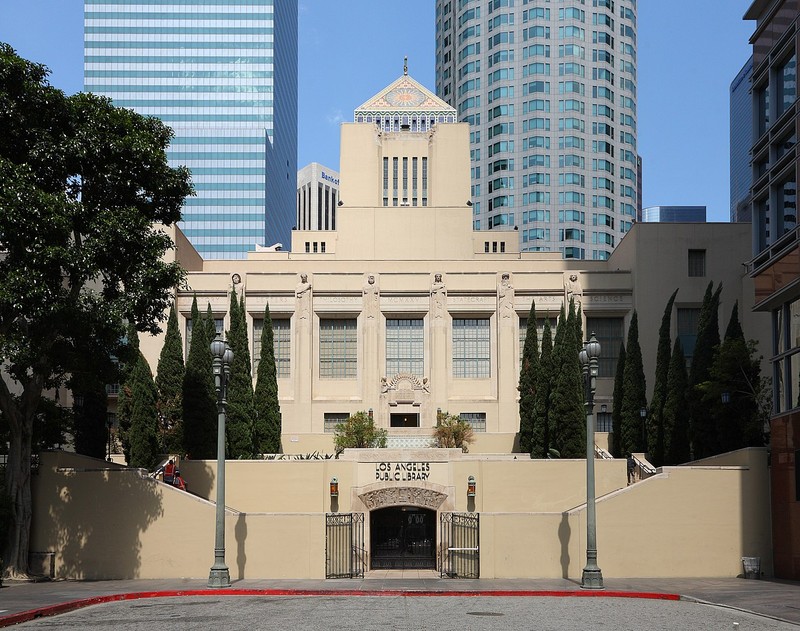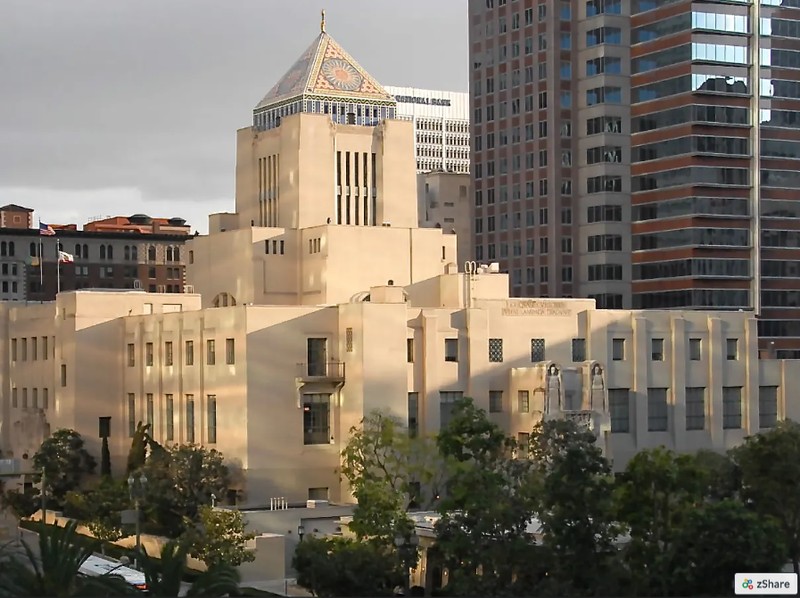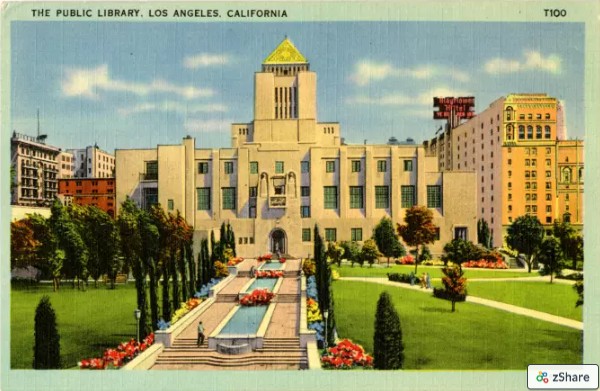Los Angeles Central Library (Richard J. Riordan Central Library)
Introduction
Text-to-speech Audio
This historic library building opened in 1926, and its construction symbolized the final step in the growth of Los Angeles' library system which began in 1844 with a collection of books located in a room above a saloon. The city's library grew during the late nineteenth century, thanks largely to the leadership of boards and libraries that were led by women, and this building's opening served as a culmination of those early efforts. By the 1920s, the library's place within L.A. society had grown so vital that officials funded the building of an elaborate library building in downtown Los Angeles. The building survives today despite early overcrowding issues and two arson fires; a massive renovation project in the 1990s modernized and expand the library.
Images
The South Hope Street entrance of the Los Angeles Central Library in downtown Los Angeles, California.

Los Angeles Central Library

1935 Postcard LA Central Library

Backstory and Context
Text-to-speech Audio
The history of the library in the Los Angeles area dates back to 1844 when in a town supporting less than 1,500 people, residents started a collection of donated books and newspapers. The collection was kept in various places, including donated quarters above a saloon, City Hall, and a department store.
At a time when few women were permitted to hold public positions, librarians were often staffed by women and led by boards appointed by city leaders that often had women at the helm. The boards and early library staff took charge of establishing, developing, and growing the city's library. From 1880 to 1905, a series of independent-minded women served as city librarians. In an era when few women held government careers, librarianship provided a way for women to demonstrate executive abilities. Under the women's leadership, Los Angeles' library system gained credibility.
Mary Emily Foy served as the city library's first innovator when the library was in the upstairs quarters of a saloon. Foy took the position after the dismissal of her two predecessors: one for smoking foul-smelling jimsonweed to ward off asthma attacks and the other for alcohol (whiskey) abuse. Foy, an outspoken feminist, not only served as a referee during chess matches and bets made between saloon patrons, but she also set up a Dewey Decimal card-catalog system and hosted the Ladies Reading Room. Meanwhile, another of the library's women leaders, Tessa Kelso, smoked cigarettes in public, wore her hair short, and beat back a clergyman’s attempts to remove a risque French novel from the shelves. As a librarian, she increased the library collection sevenfold during her leadership from 1889 to 1895. Under Kelso's direction, library card ownership rose from 132 to more than 20,000, largely due to her abolishing fees and making book-borrowing free.
Despite the accomplishments of the women who built the library, the story of Mary Jones speaks to the uphill battle women faced, even in the library system. Jones, in 1905 was ousted from her position to make way for Theodore Roosevelt's former Harvard Classmate, Charles Fletcher Lummis. Jones sued, but the city attorney upheld Lummis' appointment. In 1910, Charles Lummis took over as chief librarian and expanded the library while also serving as a strong advocate for Native American rights and preserving their history. Despite the controversial removal of Jones, Lummis did put his stamp on the L.A. library system and is now part of the California Library Hall of Fame; he also gained fame for his social-justice activism.
The one-time reporter for the Los Angeles Times, he passionately promoted Southwestern U.S. culture, actively preserved Spanish missions, founded the Southwest Museum, wrote for and published magazines, and authored books. Furthermore, he was a crusader for civil rights for minorities, notably American Indians, with whom he lived for numerous years. Indeed, Lummis was one of the first recognizable white Americans to speak out against unjust policies toward Native Americans and he served as an advisor to President Theodore Roosevelt on matters of Native Americans and civil rights.
Although he only served briefly as the chief librarian (The city fired Lummis in 1910 because he had locked the library into an expensive lease, and he gave himself a raise and a pension), Lummis expanded and diversified library services, professionalized the library’s staff, developed a system to prevent book losses, and profoundly increased the library’s historical holdings. He created a branding iron that read "LA PUB LIBRARY," which he marked on the top leaves of the books to help prevent the stealing of library books. He also despised books that romanticized certain aspects of history, so he inserted a “poison” label in any book he deemed to contain dubious narratives.
By 1921, the passage of a special bond issue cleared the way for the city to build a permanent home for its library, considered by many as a show of the city's maturation. The city acquired land for only $1 on the former site of the State Normal School, which became the University of California Los Angeles (UCLA). Bertram Grosvenor Goodhue, who designed such buildings as the Nebraska State Capitol and Throop Polytechnic Institute in Pasadena (now Caltech), served as the architect for the Central Library. Goodhue chose to design the building using a mix of influences from Spanish, Roman, and Egyptian styles.
While aesthetically pleasing, its function soon proved inadequate. Designed to hold one million books, the shelving accommodations quickly grew insufficient, and its electrical capacity, among many other modern needs, was markedly inadequate; plugging in simple coffeepots blew circuits. The city debated how to expand or change the library for decades, and then two arson fires in 1986 created further challenges. The first fire, in spring, destroyed 400,000 books and documents; another fire in fall did less damage. The fires helped galvanize the library supporters into raising money and volunteering to help the library. Then in 1987, the city sold the air rights of the library property for $214 million, which funded a six-year renovation project that modernized and expanded Central Library.
Cite This Entry
Powers, Mathew and Clio Admin. " Los Angeles Central Library (Richard J. Riordan Central Library)." Clio: Your Guide to History. October 18, 2022. Accessed April 26, 2025. https://theclio.com/tour/301/7
Sources
California Library Hall of Fame. "Charles Lummis (1859-1928)." cla-net.org. Accessed October 12, 2022. https://www.cla-net.org/page/665.
Marshall, Colin. "Los Angeles in Buildings: The Central Library." Public Media Group of Southern California, PBS-KCET. August 2, 2017. https://www.kcet.org/shows/lost-la/los-angeles-in-buildings-the-central-library.
Ohanesian, Liz. "Los Angeles Central Library: The Story of an L.A. Icon." Los Angeles Tourism & Convention Board: Discover Los Angeles. Arts and Culture sec. September 6, 2019. https://www.discoverlosangeles.com/things-to-do/los-angeles-central-library-the-story-of-an-la-icon.
Rasmussen, Cecilia. "Storied History of Central Library Speaks Volumes." Los Angeles Times (Los Angeles), March 24, 2022.
Thompson, Mark. American Character: The Curious Life of Charles Fletcher Lummis and the Rediscovery of the Southwest. New York: Arcade Publishing, 2001.
By Mfield, Matthew Field, http://www.photography.mattfield.com - Own work, GFDL 1.2, https://commons.wikimedia.org/w/index.php?curid=6420678
Richard J. Riordan Central Library | Photo: LAPL, https://www.discoverlosangeles.com/things-to-do/los-angeles-central-library-the-story-of-an-la-icon
PBS-KCET: https://www.kcet.org/shows/lost-la/los-angeles-in-buildings-the-central-library

